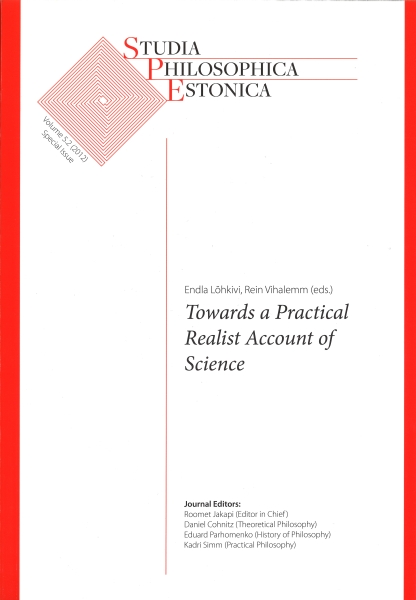Order out of Chaos? A Case Study in High Energy Physics
DOI:
https://doi.org/10.12697/spe.2012.5.2.05Keywords:
philosophy of simulation, causality, experimentAbstract
In recent years, computational sciences such as computational hydrodynamics or computational field theory have supplemented theoretical and experimental investigations in many scientific fields. Often, there is a seemingly fruitful overlap between theory, experiment, and numerics. The computational sciences are highly dynamic and seem a fairly successful endeavor---at least if success is measured in terms of publications or engineering applications. However, for theories, success in application and correctness are two very different things; and just the same may hold for "methodologies" like computer simulations. A lively debate on the epistemic status of computer simulations has thus emerged within the philosophy of science. This paper discusses possible problems when computer simulation and laboratory experiment are intertwined. In present experiments, stochastic methods in the form of Monte Carlo simulations are often involved in generating experimental data. It is questioned as to how far a realistic stance can be maintained when such stochastic elements are involved. Taking experiments in high energy physics as a study case, this paper contends that using these types of entangled material and numerical experiments as a source of new phenomena or for theory testing must presuppose a certain understanding of causality and thus binds us at least to a weak form of realism.
Downloads
References
Ackerstaff, K. et al. (2000). Nuclear effects on R = sL/sT in deep-inelastic scattering, Physics Letters B475: 386-394.
Airapetian, A. et al. (2003). Erratum to: Nuclear effects on R = sL/sT in deep-inelastic scattering, Physics Letters B567: 339-346.
Amaro, E. J. and Barker, G. (2006). Study design in fMRI: Basic principles, Brain and Cognition 60: 220-232.
Appel, K. and Haken, W. (1977). Every planar map is four colorable. part I: Discharging, Illinois Journal Mathematics 21: 429-490.
Avakian, H. et al. (1998). Performance of the electromagnetic calorimeter of the HERMES experiment, Nuclear Instruments and Methods in Physics Research A417: 69-78.
Duhem, P. (1906). La ThÉorie physique – son object, et sa structure, Chevalier et Rivière, Paris. cited after the English translation The Aim and Structure of Physical Theory.
Frigg, R. and Reiss, J. (2009). The philosophy of simulation: Hot new issues or same old stew?, Synthese 169: 593-613. Galison,P. (1997). Imageand Logic: A Material Culture of Microphysics, University of Chicago Press, Chicago.
Giere, R. (2009). Is computer simulation changing the face of experimentation?, Philosphical Studies 143: 59-62.
Grauer, R., Marliani, C. and Germaschewski, K. (1998). Adaptive mesh refinement for singular solutions of the incompressible Euler equations, Physical Review Letters 84: 4850-4853.
Hacking, I. (1983). Representing and Intervening, Cambridge University Press, Cambridge.
Hartmann, S. (1996). The world as a process, in R. Hegselmann, U. Mueller and K. G. Troitzsch (eds), Modelling and Simulation in the Social Sciences from the Philosophy of Science Point of View, Springer, Dordrecht, pp. 77-100.
Heidelberger, M. (2003). Theory-ladeness and scientific instruments in experimentation, in H.Radder(ed.), The Philosophy of Scientific Experimentation, Pittsburgh University Press, Pittsburgh, pp. 138-151.
Hillerbrand, R. (2012). Computer simulation – The future of experiment or theoretical phantasies? Epistemic aspects of numerical experiments.
Hughes, R. (1999). The Sing Model, computer simulations and universal physics, in M. Morgan and M. Morrison (eds), Models as mediators: Perspectives on natural and social science, Cambridge University Press, Cambridge, pp. 97-145.
Humphreys, P. (1991). Computer simulations, in A. Fine, M. Forbes and L. Wessels (eds), PSA: Proceedings of the Biennial Meeting of the Philosophy of Science Association 199 University of Chicago Press, East Lansing, pp. 497-506.
Humphreys, P. (2004). Extending ourselves. Computer science, empiricisms and scientific method, Oxford University Press, Oxford.
Humphreys, P. (2009). The philosophical novelty of computer simulation methods, Synthese 169: 615-626.
Kalos, M. and Whitlock, P. (2008). Monte Carlo Methods, Wiley-VCH.
Kuhn, T. (1962). The Structure of Scientific Revolution, University of Chicago Press.
Manno, I. (1999). Introduction to the Monte Carlo Method, Akademiai Kiado, Budapest.
McMullin, E.(1985). Galilean idealization, Studiesin the History and Philosophy of Science 16: 247-273.
Metropolis, N. and Ulam, S. (1949). The monte carlo method, Journal of the American Statistical Association 44: 335-341.
Morgan, M. (2003a). Experiments without material intervention: Model experiments, virtual experiments and virtually experiments, in H. Radder (ed.), The Philosophy of scientific experimentation, Pittsburgh University Press, Pittsburgh, pp. 216-235.
Morgan, M. (2003b). Model experiments and model in experiments, in L. Magnani and N. Nersessian (eds), Model based-reasoning: Science, technology and values Kluwer, New York, pp. 41-58.
Morrison, M. (2009). Models, measurment and computer simualtion: The changing face of experimentation?, Philosphical Studies 143: 33-57.
Niiniluoto, I. (1999). Critical Scientific Realism, Oxford University Press, New York.
Oreskes, N., Shrader-Frechette, K. and Belitz, K. (1994). Verification, validation, and confirmation of numerical models in the earth science, Science 263: 641-646.
Parker, W. (2009). Does matter really matter? Computer simulations, experiments, and materiality, Synthese 169: 483-496.
Rohrlich, F. (1991). Computer simulation in the physical sciences, in A. Fine, M. Forbes and L. Wessels (eds), PSA: Proceedings of the Biennial Meeting of the Philosophy of Science Association 199 University of Chicago Press, East Lansing, pp. 507-518.
Rouse, J. (2002). How Scientific Practices Matter: Reclaiming Philosophical Naturalism, University of Chicago Press, Chicago.
Soler, L., Trizio, E., Nickles, T. and Wimsatt, W. (eds) (2012). Characterizing the Robustness of Science: After the Practice Turn in Philosophy of Science, Springer, Dordrecht.
Vihalemm, R. (2012). Practical realism: Against standard scientific realism and anti-realism, Studia Philosophica Estonica 5.2: 123-456.
Ward, B. (2000). Simultaneous inference for FMRI data. URL: http://afni.nimh.nih.gov/pub/dist/doc/manual/AlphaSim.pdf
Winsberg, E. (2009). A tale of two models, Synthese 169: 575-592.
Wolfram, S. (1994). Cellular Automata and Complexity, Addison-Wesley, Reading.

